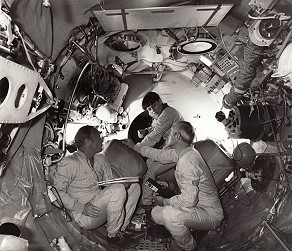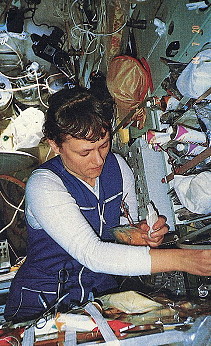Human Spaceflights
![]()
International Flight No. 96Soyuz T-12PamirUSSR |
 |
![]()
Launch, orbit and landing data
walkout photo |
 |
|||||||||||||||||||||||
alternative crew photo |
alternative crew photo |
|||||||||||||||||||||||
alternative crew photo |
alternative crew photo |
|||||||||||||||||||||||
alternative crew photo |
alternative crew photo |
|||||||||||||||||||||||
Crew
| No. | Surname | Given names | Position | Flight No. | Duration | Orbits | |
| 1 | Dzhanibekov | Vladimir Aleksandrovich | Commander | 4 | 11d 19h 14m 36s | 186 | |
| 2 | Savitskaya | Svetlana Yevgeniyevna | Flight Engineer | 2 | 11d 19h 14m 36s | 186 | |
| 3 | Volk | Igor Petrovich | Research Cosmonaut | 1 | 11d 19h 14m 36s | 186 |
Crew seating arrangement
|
 |
|
||||||||||||||||
Backup Crew
|
 |
||||||||||||||||||||
alternative crew photo |
|||||||||||||||||||||
alternative crew photo |
|||||||||||||||||||||
alternative crew photo |
|||||||||||||||||||||
alternative crew photo |
Hardware
| Launch vehicle: | Soyuz-U2 (No. Yu15000-006) |
| Spacecraft: | Soyuz T-12 (7K-ST No. 18L) |
Flight
|
Launch from the Baikonur Cosmodrome and
landing 140 km southeast of Dzheskasgan. Igor Volk was a test pilot, and was planned to be the Commander of the first Buran spaceflight. The rule introduced following the Soyuz 25 failure, insisted that all Soviet spaceflight must have at least one crew member who has been to space before. As a result, it was decided that Igor Volk should have spaceflight experience, and he was originally scheduled to visit Salyut 7 in 1983. But following the failure of Soyuz T-8 to dock to Salyut 7, in April 1983, the Soyuz launch schedule was disrupted, and Igor Volk's original crew members, Leonid Kizim and Vladimir Soloviyov, were rescheduled elsewhere. They later became long-duration crew members of the third resident crew, and Igor Volk was scheduled fly in the passenger seat of a visiting mission Soyuz T-12 to the third resident crew, but the other members of the Soyuz T-12 mission were not yet decided upon. Following a one-day solo flight Soyuz T-12 docked with Salyut 7 on July 18, 1984 and common work with the third resident crew was done. An EVA by Vladimir Dzhanibekov and Svetlana Savitskaya was performed on July 25, 1984 (3h 33m). For this first EVA by a woman, Svetlana Savitskaya donned an Orlan-D suit already worn eight times by cosmonauts on Salyut 7. With Vladimir Dzhanibekov, she was tasked with testing the Universalny Rabochy (or Ruchnoj) Instrument ("Universal Hand Tool") (URI) multipurpose electron beam cutting, welding, soldering, and brazing tool. Svetlana Savitskaya played a central role in developing the handle and other cosmonaut interfaces of the tool. She trained with URI three times in a vacuum chamber and in a plane flying parabolas. Some engineers voiced reservations about flying URI - it generated a great deal of heat which might damage the cosmonauts' space suits. The experience of the Vulkan automated welding system 15 years before loomed large in engineers' minds (the device ran amok aboard Soyuz 6 and nearly cut the table holding welding samples in half). On day 7 with Igor Volk inside Salyut 7 monitoring the EVA timeline, Vladimir Dzhanibekov opened the Salyut 7 airlock. He unfolded and stood in a Yakor foot restraint, then set up a worksite lamp. Svetlana Savitskaya handed out URI, which Vladimir Dzhanibekov set up and attached to an external power outlet. He then traded places with Svetlana Savitskaya, who set up a TV camera. Salyut 7 passed out of communications range with the TsUP; when contact was restored, Svetlana Savitskaya began work with URI, first cutting a 0.5-mm- (0.02-in-) thick titanium sample. In all she performed six cutting, two silver spray coating, and six soldering experiments, taking care always not to point URI at Salyut 7 lest the tool run amok. Her heart rate peaked during the EVA at 140 beats/minute. While soldering the Sun glared in her face, making it difficult for her to see her work; nevertheless, her results were later judged satisfactory. Svetlana Savitskaya and Vladimir Dzhanibekov then traded places again so he could test URI. Vladimir Dzhanibekov said later that "the tool is very handy and I'm sure we'll be using it a lot." After finishing, he took down URI and handed the device and experiment samples to Svetlana Savitskaya. Vladimir Dzhanibekov then removed Ekpozitsiya cassettes from the station's exterior and handed them to Svetlana Savitskaya, who handed back a Meduza bio-polymer cassette for installation. Products of the welding experiment returned to Earth in Soyuz T-12. The common work with the third resident crew included rezonans tests and collecting station air samples. The Soyuz spacecraft is composed of three elements attached end-to-end - the Orbital Module, the Descent Module and the Instrumentation/Propulsion Module. The crew occupied the central element, the Descent Module. The other two modules are jettisoned prior to re-entry. They burn up in the atmosphere, so only the Descent Module returned to Earth. The deorbit burn lasted about 3 to 4 minutes. Having shed two-thirds of its mass, the Soyuz reached Entry Interface - a point 400,000 feet (121.9 kilometers) above the Earth, where friction due to the thickening atmosphere began to heat its outer surfaces. With only 23 minutes left before it lands on the grassy plains of central Asia, attention in the module turned to slowing its rate of descent. Eight minutes later, the spacecraft was streaking through the sky at a rate of 755 feet (230 meters) per second. Before it touched down, its speed slowed to only 5 feet (1.5 meter) per second, and it lands at an even lower speed than that. Several onboard features ensure that the vehicle and crew land safely and in relative comfort. Four parachutes, deployed 15 minutes before landing, dramatically slowed the vehicle's rate of descent. Two pilot parachutes were the first to be released, and a drogue chute attached to the second one followed immediately after. The drogue, measuring 24 square meters (258 square feet) in area, slowed the rate of descent from 755 feet (230 meters) per second to 262 feet (80 meters) per second. The main parachute was the last to emerge. It is the largest chute, with a surface area of 10,764 square feet (1,000 square meters). Its harnesses shifted the vehicle's attitude to a 30-degree angle relative to the ground, dissipating heat, and then shifted it again to a straight vertical descent prior to landing. The main chute slowed the Soyuz to a descent rate of only 24 feet (7.3 meters) per second, which is still too fast for a comfortable landing. One second before touchdown, two sets of three small engines on the bottom of the vehicle fired, slowing the vehicle to soften the landing. |
EVA data
| Name | Start | End | Duration | Mission | Airlock | Suit | |
| EVA | Dzhanibekov, Vladimir | 25.07.1984, 14:55 UTC | 25.07.1984, 18:28 UTC | 3h 33m | Soyuz T-12 | Salyut 7 | Orlan-D No. 47 |
| EVA | Savitskaya, Svetlana | 25.07.1984, 14:55 UTC | 25.07.1984, 18:28 UTC | 3h 33m | Soyuz T-12 | Salyut 7 | Orlan-D No. 45 |
Photos / Graphics
 |
 |
 |
 |
 |
 |
 |
 |
 |
 |
 |
 |
 |
 |
 |
 |
 |
 |
 |
 |
more EVA photos |
|
| © |  |
Last update on May 16, 2021.  |
 |